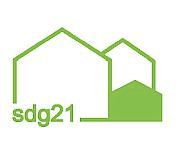Many detached houses, apartment blocks and commercial buildings are suitable for the installation of a fuel cell heating system. It generates electricity and heat at the same time.
The installation of such micro-CHP systems is also subsidised by the federal government. Dr Karsten McGovern, Head of the State Energy Agency (LEA), says: "Hesse has been supporting fuel cell heating as a building block for the heating transition in the boiler room for many years. Building on the positive long-term experience of the Hessian funding programme from 2014/15, we would like to motivate even more Hessian consumers to opt for this innovative heating technology." To this end, the LEA has launched an information and advice campaign on behalf of the Hessian Ministry of Economics.
In a fuel cell heating system, natural gas is converted into electricity and heat according to the principle of cold combustion. Their use is not only favoured by their efficiency - they have the highest energy efficiency compared to other heating systems on the market - but also by the massive reduction in emissions. For example, the CO2 footprint of a household can be reduced by more than a tonne (for comparison: the average CO2 emissions per capita in Germany in 2018 were just under 12 tonnes). In addition, other harmful emissions such as nitrogen oxides or particulate matter are almost completely eliminated. The electricity generated as a "by-product" can also be utilised and makes a significant contribution to reducing a household's energy costs. Surplus electricity can also be fed into the public grid and is remunerated.
KfW promotes the installation of fuel cell heating systems for private consumers as well as for commercial users and local authorities on behalf of the federal government with the programme 433 "Energy-efficient construction and renovation - fuel cell grant". The subsidy amounts to between 7,050 and 28,200 euros, depending on the electrical output. The subsidy is made up of a fixed basic amount and a performance-related component per 100 watts or part thereof.
"By the beginning of 2019, more than 5,000 fuel cell heating systems had been funded across Germany via the KfW 433 programme. We want to support this positive development in Hesse in order to firmly establish the fuel cell on the market for heating systems," continued Dr McGovern. With the campaign, the LEA is informing consumers and potential commercial users about the technology and the current range of subsidies on offer, as well as the practical implementation and operation of the system. A key component of this is also the offer of free orientation advice: interested parties can complete a checklist and send it to the LEA; they will then receive a qualified initial assessment of whether the property in question is also suitable for fuel cell heating and what the next steps towards realisation are. The advisory programme will be advertised throughout Hesse over the next few weeks, including on the radio.
*******************************************************
HA Hessen Agentur GmbH is the state's service company. It implements projects, campaigns and promotional activities and also acts as a consultant and "think tank". Its core objective is to provide the best possible support to the state of Hesse and other public institutions in achieving their goals within the framework of Hessian economic development. Further information can be found at www.hessen-agentur.de
On behalf of the Hessian state government, the State Energy Agency (LandesEnergieAgentur - LEA) takes on central tasks in the implementation of the energy transition and climate protection. One focus of its activities is aimed at Hessian municipalities, which can receive support with strategies and measures for climate protection and the expansion of renewable energies. LEA also sees itself as an information platform and provides information for citizens, companies and organisations in Hesse. www.landesenergieagentur-hessen.de
Source: LEA press release from 16 May 2019
Keywords:
Funding, News Blog Hesse





